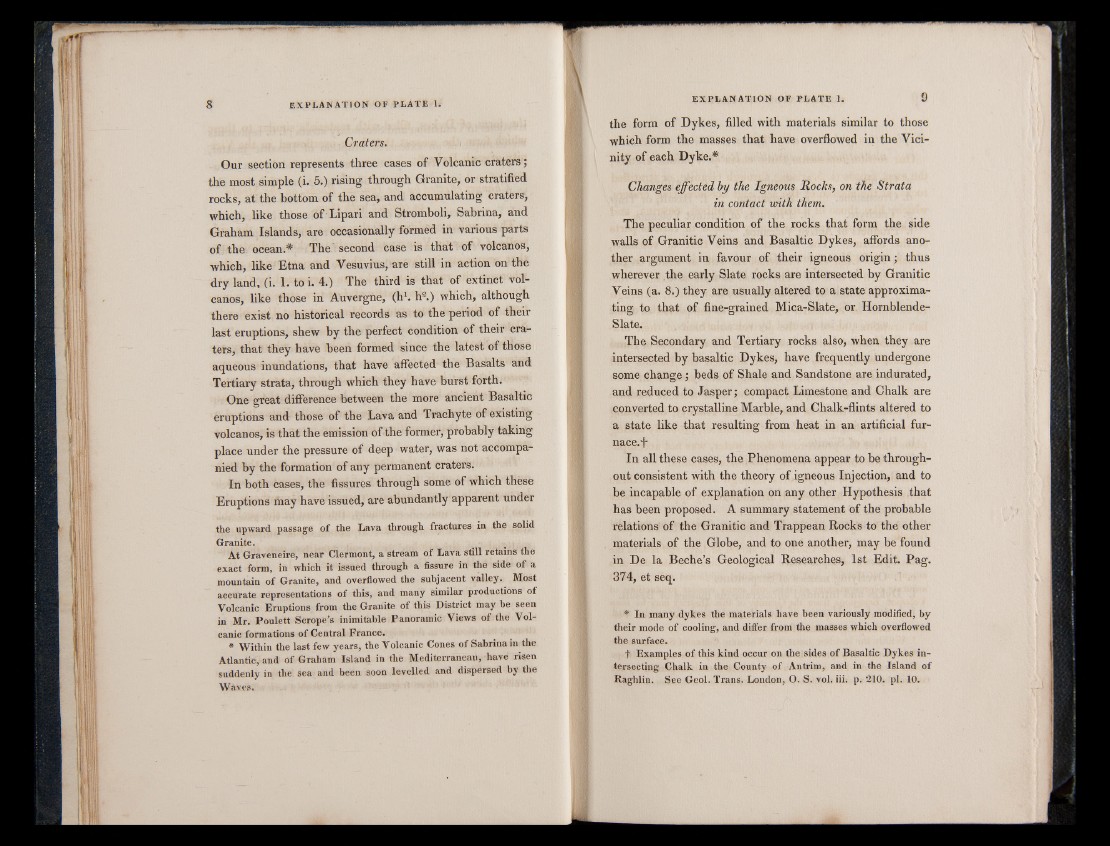
Craters.
Our section represents three cases of Volcanic craters;
the most simple (i. 5.) rising through Granite, or stratified
rocks, at the bottom of the sea, and accumulating craters,
which, like those ofLipari and Stromboli, Sabrina, and
Graham Islands, are occasionally formed in various parts
of the ocean.* The second case is that of volcanos,
which, like Etna and Vesuvius, are still in action on the
dry land, (i. 1. to i. 4.) The third is that of extinct volcanos,
like those in Auvergne, (h1. h2.) which, although
there exist no historical records as to the period of their
last eruptions, shew by the perfect condition of their craters,
that they have been formed since the latest of those
aqueous inundations, that have affected the Basalts and
Tertiary strata, through which they have burst forth.
One great difference between the more ancient Basaltic
eruptions and those of the Lava and Trachyte of existing
volcanos, is that the emission of the former, probably taking
place under the pressure of deep water, was not accompanied
by the formation of any permanent craters.
In both cases, the fissures through some of which these
Eruptions may have issued, are abundantly apparent under
the upward passage of the Lava through fractures in the solid
Granite.
At Graveneire, near Clermont, a stream of Lava still retains the
exact form, in which it issued through a fissure in the side of a
mountain of Granite, and overflowed the subjacent valley. Most
accurate representations of this, and many similar productions of
Volcanic Eruptions from the Granite of this District may be seen
in Mr. Poulett Scrope’s inimitable Panoramic Views of the Volcanic
formations of Central France.
* Within the last few years, the Volcanic Cones of Sabrina in the
Atlantic, and of Graham Island in the Mediterranean, have risen
suddenly in the sea and been soon levelled and dispersed by the
Waves.
the form of Dykes, filled with materials similar to those
which form the masses that have overflowed in the Vicinity
of each Dyke.*
Changes effected by the Igneous Rocks, on the Strata
in contact with them.
The peculiar condition of the rocks that form the side
walls of Granitic Veins and Basaltic Dykes, affords another
argument in favour of their igneous origin; thus
wherever the early Slate rocks are intersected by Granitic
Veins (a. 8.) they are usually altered to a state approximating
to that of fine-grained Mica-Slate, or Hornblende-
Slate.
The Secondary and Tertiary rocks also, when they are
intersected by basaltic Dykes, have frequently undergone
some change; beds of Shale and Sandstone are indurated,
and reduced to Jasper; compact Limestone and Chalk are
converted to crystalline Marble, and Chalk-flints altered to
a state like that resulting from heat in an artificial fur-
nace.f
In all these cases, the Phenomena appear to be throughout
consistent with the theory of igneous Injection, and to
be incapable of explanation on any other Hypothesis that
has been proposed. A summary statement of the probable
relations of the Granitic and Trappean Rocks to the other
materials of the Globe, and to one another, may be found
in De la Beche’s Geological Researches, 1st Edit. Pag.
374, et seq.
* In many dykes the materials have been variously modified, by
their mode of cooling, and differ from the masses which overflowed
the surface.
f Examples of this kind occur on the sides of Basaltic Dykes intersecting
Chalk in the County of Antrim, and in the Island of
Raghlin. See Geol. Trans. London, O. S. vol. iii. p. 210. pi. 10.